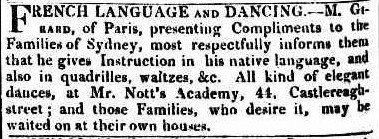
Girard’s first advertisment in the Sydney Gazette
28 October 1820, five weeks after arriving in Sydney.
No portrait of François Girard exists, yet from the convict records a fascinating image emerges. Twenty-seven years old upon arrival in Sydney of “dashing appearance and pleasing address” 1, François was 5 feet 6 inches tall, with a sallow complexion, hazel eyes and brown hair. He was to become one of the richest entrepreneurs in the colony.
François Girard [alias, De Lisle] was born in Normandy in 1793, the year the French guillotined their king and declared war on Britain. François served as an officer in Napoleon’s army (perhaps the young relative of General Girard) and may have fought at the Battle of Waterloo. He left France after the fall of the Emperor’s regime and sought a living in England as a teacher of the French language. In 1820, he was convicted in Middlesex for stealing two gold watches and sentenced to seven years transportation. Historian Kenneth R. Dutton 2 suggests that all Frenchmen residing in England were viewed as possible revolutionaries, and given the inconsistencies in his trials, François may have been falsely convicted to remove him from England’s shores.
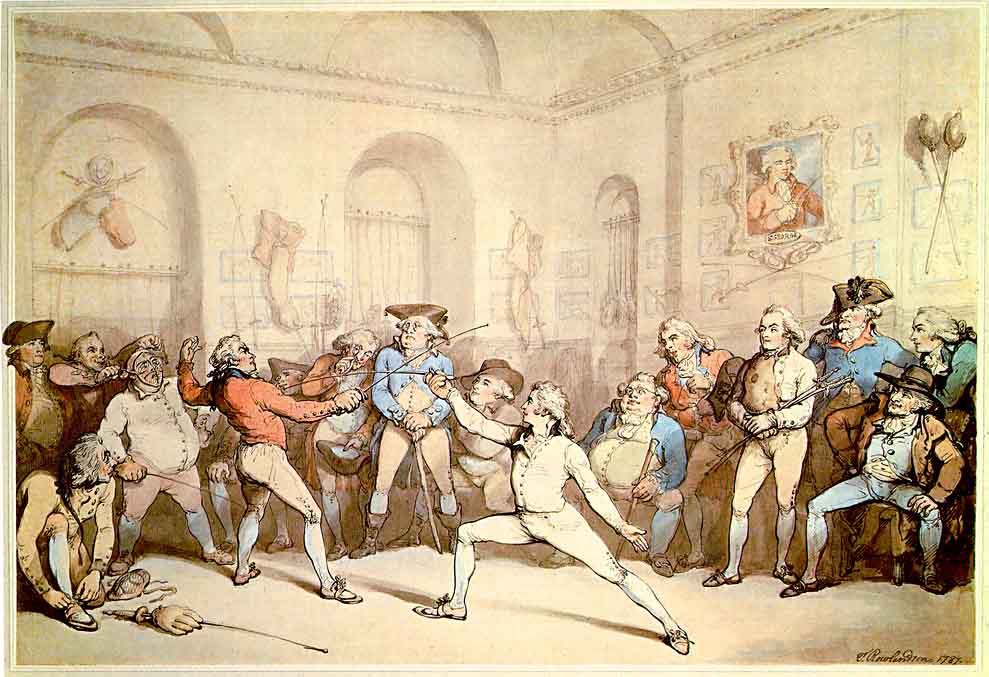
The gentlemanly accomplishment of fencing was often taught by professors of dancing. It required many of the same skills – balance, agility, stamina, and fleetness of foot.
A Fencing Academy 1787.
Thomas Rowlandson
Upon arriving in the colony on Agamemnon 3, Girard was immediately recognised as a gentlemen and was “indulged in his liberty” 4. This contrasts with the lot of most convicts who were despatched soon after arrival to Parramatta, Emu Plains or Liverpool to work as labourers, either for the government or for private settlers. Within a month François was establishing himself as a prominent dancing master in Sydney.
The art of dance held a special importance in France, with Paris long recognised as the cultural heart of Europe; even during the Revolution there remained a great passion for dancing. A number of French gentlemen utilised this knowledge of dance to provide a livelihood in new lands after fleeing the wars in France, and French prisoners of war even gave dancing lessons while incarcerated on British hulks5. Perhaps François gave lessons in dancing during his voyage to Australia and realised there would be a demand for such a skill in the colony.
FRENCH LANGUAGE AND DANCING. — M. Girard, of Paris,
presenting Compliments to the Families of Sydney, most respectfully informs them that he gives Instruction in his native language, and also in quadrilles, waltzes, Sec. All kind of elegant dances, at Mr. Nott’s Academy, 44. Castlereagh street; and those Families, who desire it, may be waited on at their own houses. 6
Girard was soon employed by a number of educational institutions in Sydney, including Nott’s Academy in Castlereagh Street, Mr Wood’s Seminary and The Sydney Academy both in Macquarie Street. He also taught privately from his home at 71 Market Street, and offered classes in Parramatta, Liverpool and Windsor. He provided instruction in a wide range of fashionable dances, including country dances, waltzes, quadrilles, English and French Dancing. Girard was responsible for the first known advertisement in the colony offering lessons in the quadrille. In the same issue of the Sydney Gazette 7, Reichenberg advertised the sheet music for his compositions, the first quadrille music published in Australia.
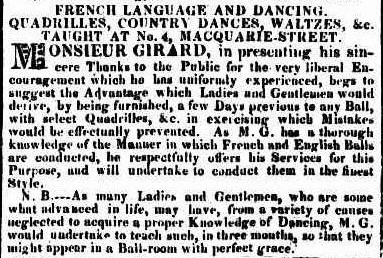
Girard’s advertisement in the Sydney Gazette of 5 May 1825 extending an invitation to the socially aspiring older “Ladies and Gentlemen” of the colony.
Francis (spelling anglicised c.1824) continued to provide dancing, fencing and French lessons for five years, which supported him beyond his expectations 8. Although other dance teachers were active in the colony, Girard was certainly the most prominent, as noted in Peter Cunningham’s “Two Years in New South Wales” 9:
Music masters for the piano and harp take regular circuits to give lessons to the rising fair; while Mons. Giraud, and other professors of attitudes and dancing, teach them to hold their heads up, turn out their toes and trip it along in waltzes, quadrilles, and contre danses.
In 1824, Francis Girard was united in marriage according to the rites of the Roman Catholic Church 10 to Mary Hayes, the daughter of Irish rebel, Michael Hayes, who had been transported to Norfolk Island where Mary was born. Francis and Mary’s family grew to include twelve children, though not all survived to adulthood.
On 12 April 1825 Girard received a conditional pardon11. Shortly thereafter, he abandoned his calling as a dancing master and became a baker, providing:
Bread of the best Quality, and also every kind of Fancy Bread ; likewise he will keep Bread, of a superior quality, for Gentlemen’s Tables,
N.B. French Hot Rolls, at half past 7 in the Morning.12
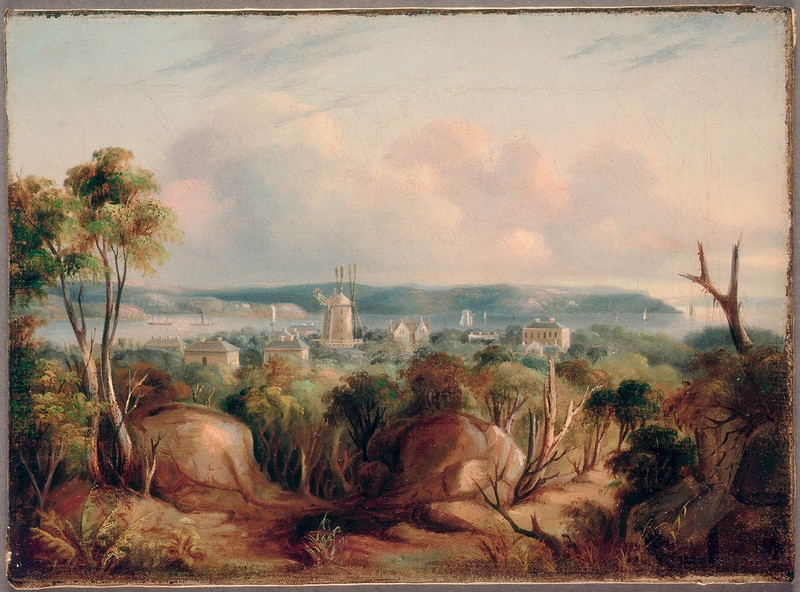
Girard’s windmill. View north from Craigend looking over Woolloomooloo and Port Jackson, 1845 / oil painting by George Edwards Peacock. Courtesy of State Library of NSW Call no. DL 15
He was awarded the government contract to supply all of Sydney’s military and convicts with bread. Further contracts to supply the troops and convicts at Parramatta and Liverpool followed. With this lucrative business, Girard erected a windmill on Woolloomooloo Hill (later Kings Cross) for the milling of grain.
He became involved in a number of other businesses with variable success: a coffee room a la Française for the Ladies and Gentlemen of Sydney, the Sydney Hotel in George Street, and a produce store at King’s Wharf. Girard’s legacy in Sydney is Napoleon Street, the thoroughfare he named which ran from Sussex Street down to his Darling Harbour wharf.
By 1837 he was plying the North Coast of NSW with his three ships; the primary trade being the cutting, transporting, and milling of cedar.
Maurice Garland of the Manning Valley Historical Society writes :
Girard was influential in opening up the Clarence River to settlers. After 1844 he became a pastoralist specialising in sheep and bought the Branga Park Station near Walcha. The willow trees planted by Girard along the banks of the Cobrabald River, flowing through Branga Park, are said to have come from seedlings imported from St Helena, where Napoleon died in exile.13
Francis died on November 16, 1859 in Armidale, NSW.
![]() The following except from The Newcastle Courant, Saturday 2 October 1819 describes François’ crime.
The following except from The Newcastle Courant, Saturday 2 October 1819 describes François’ crime.
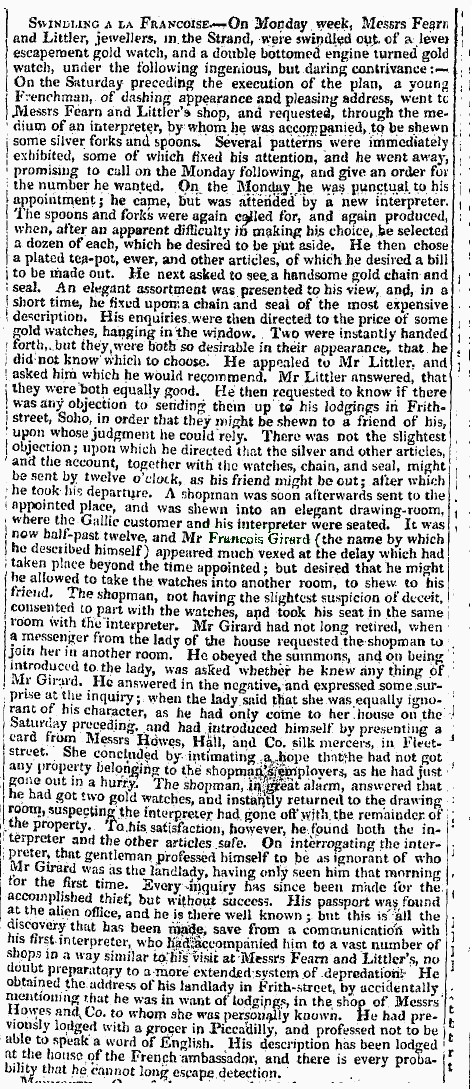 Sources
Sources
Special thanks to David Berry of the State Library of New South Wales; and Maurice Garland of the Manning Valley Historical Society for assistance with this research. Thanks too for the support of Girard’s relation, Michele.
Thanks to the State Library of New South Wales for the use of the painting of Girard’s windmill. http://www.acmssearch.sl.nsw.gov.au/search/itemDetailPaged.cgi?itemID=421324 The Australian newspaper of 30th April 1828 names Girard’s mill as the Hope Mill located next to Barker’s Barker’s (http://nla.gov.au/nla.news-article37074084) . The location is also confirmed in Len Fox’s book Old Sydney Windmills (http://library.sl.nsw.gov.au/record=b2065315~S2).
1Swindling a la Francoise.
The Hull Packet and Original Weekly Commercial, Literary and General Advertiser (Hull, England), Tuesday, September 28, 1819; Issue 1717.
2Dutton, K. R. (Kenneth Raymond), A colonial entrepreneur: Francois Girard (1792?-1859) Appears in Explorations (Clayton, Vic), no.39, Dec 2005, p.3-36 (ISSN: 0815-6158) http://trove.nla.gov.au/version/52198990
3Convict Indent for the Agamemnon (NSW Convict arrival record) State Library of NSW
4Memorial Girard addressed to Governor Darling on 31 January 1826. NSW Colonial Secretary’s Correspondence. Box 4/2039, NSW State Records.
5Garnerary, Louis. The Floating Prison. The remarkable account of nine years’ captivity on the British prison hulks during the Napoleonic Wars. 1806 to 1814 Translated from the French by Richard Rose. Conway Maritime Press, London, 2003
6Classified Advertising. (1820, October 28). The Sydney Gazette and New South Wales Advertiser (NSW : 1803 – 1842), p. 2. Retrieved January 13, 2013, from http://nla.gov.au/nla.news-article2179848
7Classified Advertising. (1825, April 28). The Sydney Gazette and New South Wales Advertiser (NSW : 1803 – 1842), p. 1. Retrieved October 15, 2012, from http://nla.gov.au/nla.news-article2183967
8Petition for mitigation of sentence. 1824 Feb 10 Of Campbelltown. (Fiche 3240; 4/1872 p.49)
9Cunningham, Peter. Two Years in New South Wales. D.S. Macmillan (ed), Angus & Robertson, 1966.
10Permission to marry Mary Hayes in the Roman Catholic Church. 1824 Aug (Reel 6064, 4/1789 p.112; Reel 6013, 4/3512 p.293) NSW Colonial Secretary’s Correspondence.
11Classified Advertising. (1825, April 21). The Sydney Gazette and New South Wales Advertiser (NSW : 1803 – 1842), p. 1. Retrieved February 19, 2013, from http://nla.gov.au/nla.news-article2183945
12 Sydney Gazette 17 May 1825
13The Swiss Swagman. Theodore Müller’s Nineteen years in Australia.
Presented by Maurice Garland, John Ramsland and Frank Pammer. Brolga Publishing, 2007
______________________________________________________________________
The information on this website www.historicaldance.au may be copied for personal use only, and must be acknowledged as from this website. It may not be reproduced for publication without prior permission from Heather Clarke.


Pingback: Australian Colonial Dance – Michelle Scott Tucker